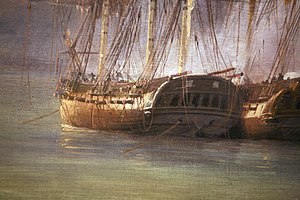French frigate Bellone (1807)
 Bellone at the Battle of Grand Port.
| |
| History | |
|---|---|
| Name | Bellone |
| Namesake | Bellona |
| Ordered | 14 January 1803 |
| Builder | Saint Servan (near Saint Malo; Ethéart company), plans by Sané |
| Laid down | March 1806 |
| Launched | 18 April 1807 |
| Commissioned | 8 May 1809 |
| Captured | 4 December 1810 |
| Name | Junon[1] |
| Acquired | 4 December 1810 by capture |
| Out of service | 1817 |
| General characteristics | |
| Class and type | Consolante-class frigate |
| Displacement | 1320 tonnes |
| Tons burthen | 109183⁄94 (bm) |
| Length | 48.75 metres (159.9 ft) |
| Beam | 12.2 metres (40 ft) |
| Draught | 5.9 metres (19 ft) |
| Propulsion | Sail |
| Armament |
|
| Armour | Timber |
Bellone was a 44-gun
French service
Bellone, under the command of
In April 1810, the squadron comprising Bellone, Minerve and Victor departed for another patrol, during which they fought the action of 3 July 1810 and the Battle of Grand Port.
Bellone was surrendered to the British when Île de France fell, on 4 December 1810.
British service
Bellone was recommissioned in the Royal Navy as HMS Junon.
In June 1812, Junon escorted a convoy from Portsmouth to India.
On 8 February 1813, nine boats and 200 men of the squadron of which Junon was part captured the
In June 1813, Junon's boats raided the James River, and she sustained an attack by US gunboats.[5]
On 3 April 1814, as she sailed with HMS Tenedos, she encountered the USS Constitution, which fled at all sail, dropping drinking water and food overboard, and eventually making it to Marblehead harbour.
Junon, Maidstone, Arab, and Curlew, shared in the detention, on 23 November of Firmina, of 260 tons (bm), Antonio Jose Fereira, master. She had been sailing from Boston to Amelia Island in ballast. The Vice admiralty court in Halifax restored her to her owners.[6]
Citations
- ^ Maclay (1900), pp. 464–5.
- ^ "No. 16712". The London Gazette. 16 March 1813. pp. 550–551.
- ^ "No. 16718". The London Gazette. 6 April 1813. p. 699.
- ^ Winfield p. 179
- ^ Vice-Admiralty Court (1911), p. 118.
References
- Fonds Marine. Campagnes (opérations ; divisions et stations navales ; missions diverses). Inventaire de la sous-série Marine BB4. Tome deuxième : BB4 1 à 482 (1790-1826) [1]
- Maclay, Edgar Stanton (1900). A history of American Privateers. Sampson, Low, Marston & Co. OCLC 606621677.
- Roche, Jean-Michel (2005). Dictionnaire des bâtiments de la flotte de guerre française de Colbert à nos jours, 1671–1870. Group Retozel-Maury Millau. p. 71. OCLC 165892922.
- Troude, Onésime-Joachim (1867). Batailles navales de la France. Vol. 4. Challamel ainé. pp. 152–153.
- Vice-Admiralty Court, Halifax (1911). American vessels captured by the British during the revolution and war of 1812. Salem, Mass.: Essex Institute. .
- Winfield, Rif (2008). British Warships in the Age of Sail 1793–1817: Design, Construction, Careers and Fates. Barnsley: Seaforth. ISBN 978-1-86176-246-7.
